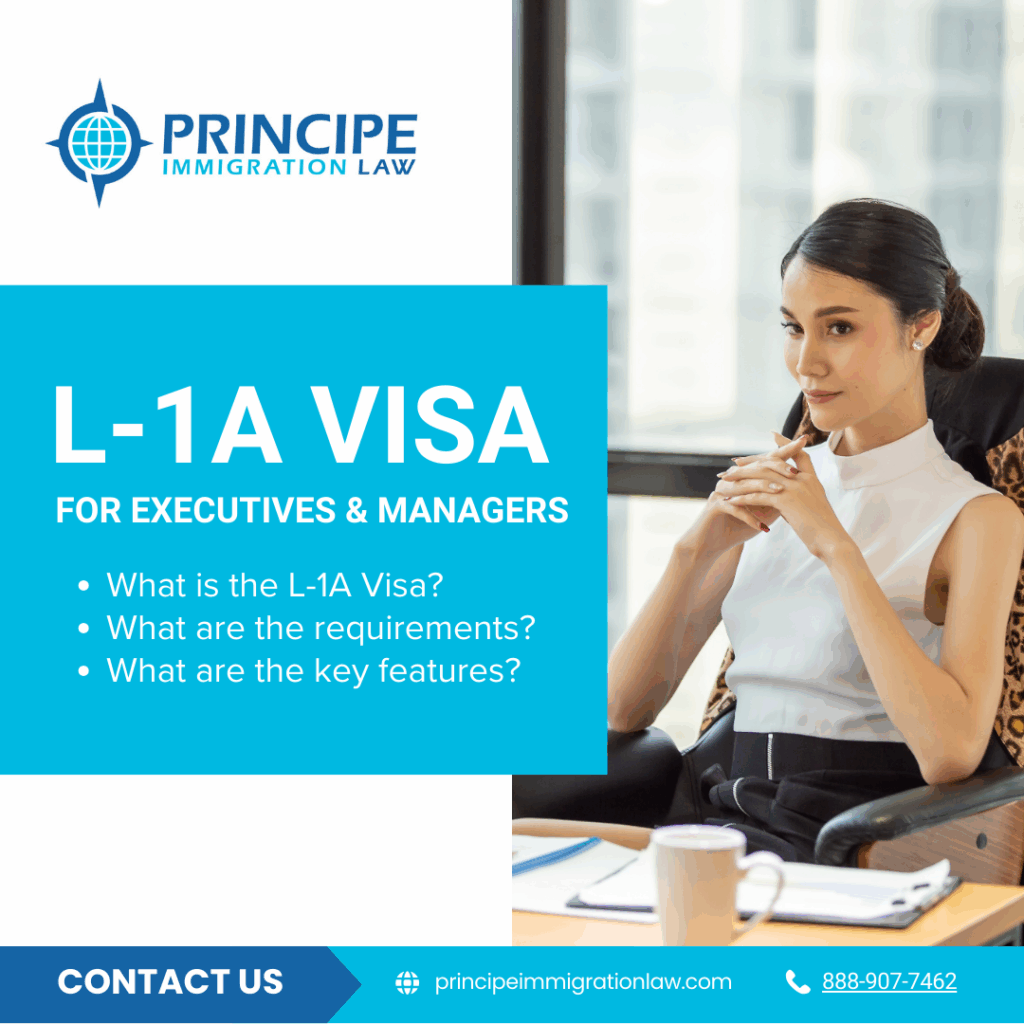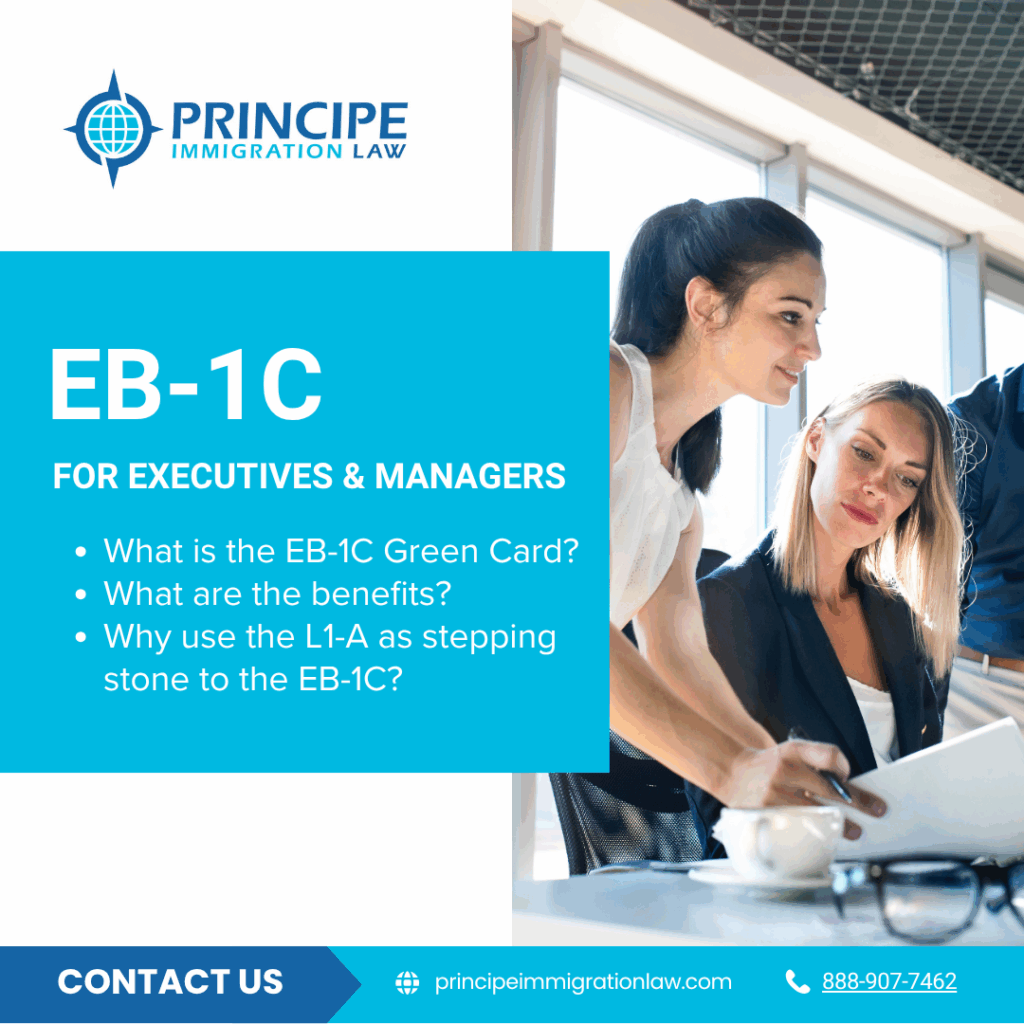From L-1A Visa to Green Card: Strategic Immigration Options for Executives & Managers
U.S. immigration law offers tailored pathways for multinational leadership talent. Two of the most strategic options are:
- The L-1A visa, which allows executives and managers to work in the U.S. on a temporary basis, and
- The EB-1C immigrant visa, which provides a pathway to a U.S. green card.
When used together, these visa options can form an effective long-term strategy for executives and managers seeking to live and work in the United States.
What Is the L-1A Visa?
 The L-1A visa enables a U.S. company to transfer an executive or manager from an affiliated foreign office to a U.S. office. It’s often used by multinational companies expanding into the U.S. market.
The L-1A visa enables a U.S. company to transfer an executive or manager from an affiliated foreign office to a U.S. office. It’s often used by multinational companies expanding into the U.S. market.
It is also a great option for foreign companies that wish to send an executive or manager to the U.S. to open a new office. L-1 visas can also be used by entrepreneurs, business owners, founders, and startups to establish (or acquire) a new business in the United States.
To qualify, the foreign national must:
- Have worked for the company abroad for at least one continuous year in the past three years;
- Be entering the U.S. to work in an executive or managerial capacity;
- Be transferring to a U.S. entity with a qualifying corporate relationship (e.g., branch, parent, subsidiary, affiliate).
Who Qualifies as a Manager or Executive?
- Executives typically direct the management of the organization or a major component or function of the organization, establish goals and policies, exercise wide latitude in discretionary decisions, and receive only general supervision.
- Managers may be:
- Personnel managers: Those who supervise “other supervisory, professional, or managerial employees” and have the authority to hire and fire, or recommend those as well as other personnel actions.
- Functional managers: Those who manage “an essential function within the organization or a department or subdivision of the organization” at a senior level, even if they don’t directly supervise employees.
*For new office L-1 petitions, the employer must also demonstrate:
- Physical premises have been secured in the U.S.
- The executive or manager meets the one-year employment abroad requirement.
- The new office will support an executive or managerial role within one year of the L-1A Petition’s approval.
Key features of the L-1A visa:
- Initial period of stay: Up to 1 year for new offices, or 3 years for existing ones.
- Extensions may be granted in 2-year increments: Up to a maximum of 7 years for executives and managers.
- No prevailing wage or investment requirement.
- No annual cap on the number of L-1 visas issued per fiscal year.
- No minimum education or degree required.
- Spouses can work incident to L-2 status in the U.S.; unmarried children under 21 years old may attend school in the USA, but are not eligible to work on an L-2 visa.
- The L-1A is a dual intent visa, meaning you can apply for a green card without jeopardizing your nonimmigrant status.
The L-1A visa is especially valuable for companies launching U.S. operations with key leadership from abroad. It supports both short-term assignments and long-term immigration goals.
What Is the EB-1C Green Card?
 The EB-1C is the employment-based immigrant visa for multinational managers and executives. It provides lawful permanent residence (a green card) without the need for a labor market test through the DOL’s labor certification process known as “PERM” (Program Electronic Review Management).
The EB-1C is the employment-based immigrant visa for multinational managers and executives. It provides lawful permanent residence (a green card) without the need for a labor market test through the DOL’s labor certification process known as “PERM” (Program Electronic Review Management).
To qualify:
- The foreign national must have worked abroad in an executive or managerial capacity for at least one continuous year in 3 years preceding the petition (or the most recent lawful L-1A nonimmigrant admission, if the foreign national is already working in the U.S.);
- The U.S. company must have been doing business for at least one year;
- The role in the U.S. must also be executive or managerial;
- The U.S. company must also be a branch, parent, subsidiary, or affiliate of the foreign company.
Advantages of EB-1C:
- Bypasses the PERM process
- Suitable for adjustment of status if the foreign national is already in the U.S. on L-1A
- No need to prove the unavailability of U.S. workers
Why Use the L-1A as a Stepping Stone to EB-1C?
In many cases, executives and managers begin their journey with an L-1A visa and later transition to the EB-1C green card. This allows them to:
- Establish themselves in a U.S. role
- Oversee and/or manage company operations
- Strengthen their green card application with a documented work history
However, timing and planning are critical. You will want to align the L-1A timeline with green card filing requirements to avoid gaps in work authorization or legal status.
Is the L-1A or EB-1C Right for You?
These categories are strong options if you:
- Are in a senior leadership or management position
- Work for a company with a qualifying U.S. entity
- Have a long-term plan to live and work in the U.S.
- Want to avoid the lengthy PERM process
Still unsure? There may be other visa options available such as the E-2 for investors or O-1 for individuals with extraordinary ability depending on your background and work experience.
FAQs
❓ Can I apply for EB-1C without first getting an L-1A?
Yes, an L-1A visa is not required to apply for EB-1C. While many clients use the L-1A as a stepping stone, it’s not mandatory. You can apply for EB-1C directly from abroad or from another U.S. visa category if you meet all the qualifications. That said, having a track record of working in the U.S. on an L-1A visa can strengthen the case.
❓ Can a startup qualify for L-1A or EB-1C?
It depends. Startups can qualify, especially if backed by an established foreign parent company. For L-1A “new office” petitions, the U.S. entity must submit a business plan, office lease, and plans to support an executive or manager role within one year. For EB-1C, the U.S. entity generally must be operating for at least one year and have the organizational structure to support the executive or managerial role on a permanent basis.
Early planning and documentation are key to successful strategy for startup-related petitions.
Why Work with Principe Immigration Law?
Strategic immigration options for executives & managers are one of our core specialties. The firm works with executives, entrepreneurs, and global companies to create strategic and streamlined U.S. immigration plans. At Principe Immigration Law, we serve as your trusted advisor and advocate throughout the visa process, from document collection and legal analysis to filing the application with USCIS and providing visa interview preparation.
When it comes to strategic immigration options for executives & managers, we have worked with petitioning employers from around the globe to understand the unique challenges of:
- Defining and demonstrating visa eligibility
- Navigating the application process
- Maintaining compliance
- Supporting family and personnel immigration needs
Let’s Talk
If your company is considering transferring key executives or managers to the U.S. using L-1A or EB-1C options or if you’re launching a startup or new U.S. entity, and aren’t sure where to begin, contact Principe Immigration Law to schedule a consultation and take the next step toward building your U.S. leadership team.
